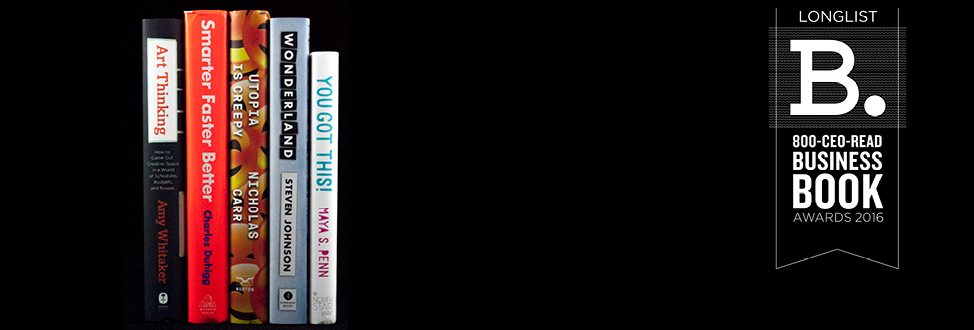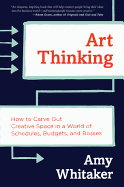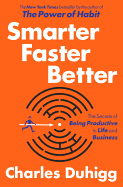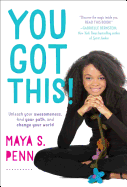Inside the Longlist: Innovation & Creativity
November 23, 2016
The five finalists in the Innovation & Creativity category span styles and subject matter, but all do one thing well: make learning interesting.
Perhaps it’s an indicator that this genre of books devoted to documenting and systematizing innovation has finally begun to show returns for itself, but innovation seems to be going strong among this year’s submissions to the selfsame category. Innovation can mean many things, and depending on your area of interest, what ranks as valid might differ greatly from the interests of your neighbor in the office park down the road. We’ve seen a great many books with very traditional how-to structures, brimming with excellent advice in digestible, applicable tips. These books aim at fostering innovation in work, and for many readers these books are invaluable. There are still also the company narratives, vignettes of CEOs and Founders who write to share their success stories, and by those we hope to gain the same valuable tips found in the aforementioned how-to style book.
Where these two kinds of books diverge is this quietly nuanced belief: either an acceptance or a rejection of the genius phenomenon. What I read is guided largely by where I land on this question of the origins of genius, which itself is a thing that for me (as I think for most people who take a moment to think) is a moving target. The regular change in my perspective forces me to take up not just the fun narratives, but also to look at more practical books rooted in the power of self-improvement. Despite the apparent difference, though, what draws me to (and keeps me there) a book of either type is one universal feature: the storytelling. Our selections for Innovation and Creativity this year are the books that bridge the typecasts and simply make learning interesting.

 A very appropriate point to begin with the category Innovation and Creativity is with one of the tenets of Amy Whitaker’s Art Thinking. Whitaker holds both an MBA and MFA, and the book is rooted in a consideration of where those two degrees intersect and overlap. Art Thinking is an elegantly written guide for creative people of all kinds, from entrepreneur to artist to account manager. Focused on skill building and business building, it is full of engaging stories and simple takeaways. I would recommend it to any businessperson who needs to get more creative, and any creative person who needs to get better at business.
A very appropriate point to begin with the category Innovation and Creativity is with one of the tenets of Amy Whitaker’s Art Thinking. Whitaker holds both an MBA and MFA, and the book is rooted in a consideration of where those two degrees intersect and overlap. Art Thinking is an elegantly written guide for creative people of all kinds, from entrepreneur to artist to account manager. Focused on skill building and business building, it is full of engaging stories and simple takeaways. I would recommend it to any businessperson who needs to get more creative, and any creative person who needs to get better at business.
 From art to science: we look next to Smarter Faster Better by Charles Duhigg. Duhigg’s legendary storytelling from The Power of Habit returns in this book devoted to making its readers more productive. One of my favorite qualities here is the freshness of the stories. Duhigg reaches for some very disparate cases to illustrate his points, and many of his subjects were new to me as a reader. These stories converge with Duhigg's greater frame for the book, which again is a very goal-oriented guide for improvement in eight areas. The book ends on a somewhat meta note, with an appendix in which Duhigg explains how he applied the lessons in the book to the process of actually writing the book. It's both a really interesting and instructive look at the creative process. If ever there was a how-to book that was not a how-to book, this is it.
From art to science: we look next to Smarter Faster Better by Charles Duhigg. Duhigg’s legendary storytelling from The Power of Habit returns in this book devoted to making its readers more productive. One of my favorite qualities here is the freshness of the stories. Duhigg reaches for some very disparate cases to illustrate his points, and many of his subjects were new to me as a reader. These stories converge with Duhigg's greater frame for the book, which again is a very goal-oriented guide for improvement in eight areas. The book ends on a somewhat meta note, with an appendix in which Duhigg explains how he applied the lessons in the book to the process of actually writing the book. It's both a really interesting and instructive look at the creative process. If ever there was a how-to book that was not a how-to book, this is it.
 Nicholas Carr’s Utopia is Creepy is going to seem like a bit of an outlier among its peers here, and that’s probably because it is. However, it’s unusual format is perhaps what makes it so rich at the same time. The book, collecting previously published blog posts and essays, makes up a kind of history of the modern world from one man’s very curious perspective (and of course, spanning a very brief period). It is a more contrarian than its contemporaries, looking askance at the vaunted "disruption" of the digital age and reminding us that creativity is a human trait, not an algorithm. Carr’s inimitable voice moves through this book from topic to topic very quickly, making it a compelling and thought-provoking read at any speed or duration.
Nicholas Carr’s Utopia is Creepy is going to seem like a bit of an outlier among its peers here, and that’s probably because it is. However, it’s unusual format is perhaps what makes it so rich at the same time. The book, collecting previously published blog posts and essays, makes up a kind of history of the modern world from one man’s very curious perspective (and of course, spanning a very brief period). It is a more contrarian than its contemporaries, looking askance at the vaunted "disruption" of the digital age and reminding us that creativity is a human trait, not an algorithm. Carr’s inimitable voice moves through this book from topic to topic very quickly, making it a compelling and thought-provoking read at any speed or duration.
 Steven Johnson returns this year with Wonderland. It is a natural follow-up to How We Got To Now, and it feeds that hunger I have for learning new and amazing things about our past, and how the connect to the world today. Johnson’s narrative leans more toward the story than the lessons learned, but the connections back to our work and life are everywhere in this book. It is a strong argument that play is just as much the mother of invention as necessity. We are moving into an age when things like fine art and gaming are becoming more integrated into our work than ever before, and Wonderland is showing us how, for centuries, entertainments like music and games and fashion to drive forward invention.
Steven Johnson returns this year with Wonderland. It is a natural follow-up to How We Got To Now, and it feeds that hunger I have for learning new and amazing things about our past, and how the connect to the world today. Johnson’s narrative leans more toward the story than the lessons learned, but the connections back to our work and life are everywhere in this book. It is a strong argument that play is just as much the mother of invention as necessity. We are moving into an age when things like fine art and gaming are becoming more integrated into our work than ever before, and Wonderland is showing us how, for centuries, entertainments like music and games and fashion to drive forward invention.
 Maya Penn’s You Got This! is also one that for me seemed at first to be an outlier, but then proved its worth in both concept and execution. The 16-year-old entrepreneur’s book serves as a guide aimed at her peers in search of direction and motivation. Penn’s style is readable and her advice sound, but what makes the book a winner is Maya herself. The book oozes personality, the writing is casual, and Penn’s impressive accomplishments elevate her beyond her years. The book takes personal development and entrepreneurship to an audience of readers for whom, statistically, creativity is in ready supply. We should anticipate the impact of books like this upon the minds of young readers, which are almost certainly littered with groundbreaking ideas.
Maya Penn’s You Got This! is also one that for me seemed at first to be an outlier, but then proved its worth in both concept and execution. The 16-year-old entrepreneur’s book serves as a guide aimed at her peers in search of direction and motivation. Penn’s style is readable and her advice sound, but what makes the book a winner is Maya herself. The book oozes personality, the writing is casual, and Penn’s impressive accomplishments elevate her beyond her years. The book takes personal development and entrepreneurship to an audience of readers for whom, statistically, creativity is in ready supply. We should anticipate the impact of books like this upon the minds of young readers, which are almost certainly littered with groundbreaking ideas.





